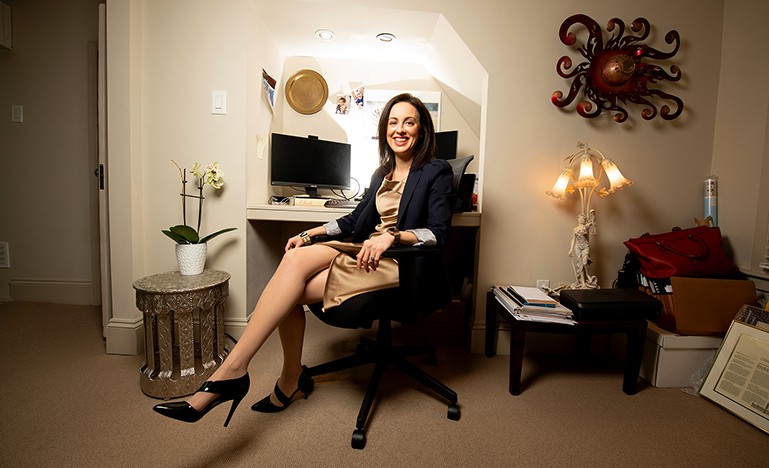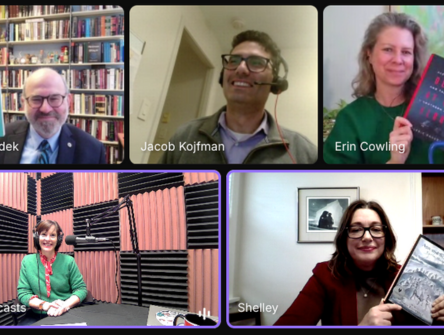Supreme Court of Canada 2022 preview
Nadia Effendi, co-chair of BLG's Appellate Advocacy Group, discusses the changing composition of the SCC, Justice Moldaver’s legacy and what to expect in the year ahead.

CBA National: Let’s start with the shape of the court. Last year we had the historic appointment of Justice Mahmud Jamal, the first person of colour to sit on the Supreme Court. Beyond that, what does he bring to the court?
Nadia Effendi: A wealth of experience. Not to say that others don’t have that, but he is trained in Canada’s bijural traditions; he’s a civil and common law lawyer. He’s perfectly bilingual; he practised in Ontario and has this formidable experience in commercial matters, notably in class actions. But he also acted as pro bono counsel in several matters involving civil liberty issues, so he is very familiar with Charter concepts. And he dealt with some of these issues when he was at the [Ontario] Court of Appeal. Putting all of that together, it’s no wonder that the legal community was unanimous in welcoming his appointment. We’ll have to stay tuned to see how he makes his mark because he hasn’t authored a decision yet. We’re anxiously waiting for that. But we know from his presence on the Ontario Court of Appeal, and as counsel, that he will play an important role and serve there for a very long time.
N: What will it be like for counsel coming before him?
NE: I had the opportunity to work with him as counsel on several occasions, and I thought he was just formidable. He is dedicated to his work and will leave no stone unturned in preparation. And so that’s really good for counsel.
N: Let’s turn to upcoming rulings. Which ones are you keeping an eye on?
NE: There are three I’m looking out for — one I was involved in. The first R. v. Sullivan (and R. v. Chan) in which the accused raised non-mental disorder automatism as a defense. The court has to grapple with this concept for the first time in a long time. The case deals with the legislative response to the Supreme Court’s decision in Daviault — probably one of the most controversial Charter decisions. After Daviault, the legislator greatly limited the notion that a person should not be convicted for a crime for which they are not morally culpable. Many people in the criminal bar will be on the lookout for that case. Beyond the confines of criminal law, there’s also the issue of the declarations of invalidity made by a superior court and whether rules of stare decisis apply. People who don’t practise criminal law will be on the lookout for it as well.
N: What else are you looking at?
NE: Anderson v Alberta is another case that the court heard in December. It dealt with the Beaver Lake Cree Nation, which filed a claim against Alberta and Canada back in 2008, seeking all sorts of remedies for damages from resource development on their traditional land. But the interesting issue is much narrower. Beaver Lake had filed an application for advanced cost to proceed with their claim. So the issue the court will have to decide when it is in the public interest to require a defendant to pay a claimant’s cost before there’s any determination? It’s a case that will have an impact on access to justice, because as we know, treaty cases can be very long and involve expensive proceedings. The ruling will potentially affect the future of Indigenous law litigation. Obviously, it has ramifications beyond the Indigenous world, but it’s a very narrow interesting issue that doesn’t come to the court often.
N: You singled out a third.
NE: The third one is Abrametz, a [disbarment] case out of Saskatchewan. The case deals with the issue of delay, but in the context of an administrative tribunal. The last time the court looked at administrative delay was roughly 20 years ago in Blencoe. Some parties argued that the court needed to take a firmer approach to administrative delay and apply a Jordanesque approach with a bright-line timeframe. If the court takes that approach, it will have a fundamental impact on many administrative agencies. Full disclosure: A few of my colleagues and I at BLG acted for the Federation of Law Societies of Canada in that case.
N: Tell us about upcoming hearings?
NE: Right now, there are five cases scheduled in January, eight in February, and ten cases in March, all covering a wide variety of issues. The first one, heard this week, exceptionally over two days, involved 23 interveners. It’s Attorney General of British Columbia v. Council of Canadians with Disabilities. At issue is the application of the public interest standing test, which could have considerable impact on public interest groups. A revised test may also influence how courts would think about the involvement of third-party groups in the intervention. The issue is not so much about groups seeking standing, but it’s about the kind of issue that the court will get to hear, if the courts decide, all of a sudden, to narrow the test significantly. The whole idea of liberal public interest standing is to help these important public law issues get before the court. Sometimes it means having public interest groups push those cases forward because individuals aren’t able to. Again, it’s another issue of access to justice.
Another case is that of [Alexandre] Bissonnette, involved in the shooting at the Quebec City mosque. Here the court gets an opportunity to re-examine the law on consecutive life sentences in the broader context of that tragedy. Bissonnette is arguing that the provisions that allow for consecutive life sentences are unconstitutional. He had basically pleaded guilty on 12 counts, including six counts of first-degree murder. So he’s looking at several life sentences consecutively. The court of appeal declared that provision 745.61 of the code invalid. Consequently, it ordered a total period of parole ineligibility of only 25 years. There was an uproar among some of the families because they wanted the ineligibility period served to be 25 years for each murder.
The SOCAN case is also being heard this month — an IP case that deals with the concept of whether or not the Copyright Board should focus solely on setting royalty rates or whether it has the ability to develop copyright jurisprudence. The IP bar will be on the lookout for what happens with that case.
And there’s Petrowest Corporation v Peace River Hydro Partners, which involves bankruptcy and the enforceability of arbitration agreements.
An interesting case not yet scheduled is Canadian Council for Refugees, which deals with the Safe Third Country Agreement between Canada and the United States, in which the U.S. was designated a safe country under our immigration and refugee regulation. As a result, claimants crossing a land border into Canada from the U.S. were deemed illegible for refugee protection in Canada. So the individual applicants in this case and who are deemed ineligible are challenging the Canadian government’s failure to review the ongoing designation of the U.S. under the regulations as rendering that provision ultra vires and not in conformity with the Act. They also claimed that this designation and their illegibility to claim refugee status infringe their Charter rights. It raises novel issues on how foreign treaty obligations may affect the state protecting Charter rights. It raises complex issues of administrative law, and frankly, it’s also one of those examples of how the Trump era policies may end up before our court, which is why it will be of interest to many people.
N: What are some of the trends you’ve noticed regarding the court’s output?
NE: First of all, in 2021, the court decided a total of 421 leave applications compared to 2020, when we had 471 cases. So it’s slightly lower than 2020 and 2019 but almost identical to 2018. And it granted leave in about 8.5% of the cases. One thing that I thought was interesting is that we saw a reversal in the type of cases granted leave. And from 2018 to 2020, the court had granted leave in substantially more civil law cases than in criminal cases. But in 2021, we saw that trend flip. The court granted leave to more criminal law cases than civil cases. Is there an explanation for that? I’m not sure. It might be timing; it might be that some of the interesting challenges have finally made their way to the Supreme Court. It can also be that the court wants to hear issues that have been raised in multiple jurisdictions. Sometimes that takes time.
N: Justice Michael Moldaver faces mandatory retirement this year. What has his legacy been?
NE: There’s no doubt that he will have left a big imprint on the court and our jurisprudence more generally. He's been a specialist on criminal law matters and he’s rendered very significant decisions in that area. One case that comes to mind is Hart in 2014, where the court established a new two-pronged test for determining the admissibility of confessions in Mr. Big operations. He was also the co-author in Jordan with Justice Justice Karakatsanis and Justice Brown. But it would be a narrow view to think of him merely as a criminal law specialist. He’s shown himself to be engaged in other issues and a very creative judge. One case that comes to mind is Ktunaxa Nation in 2017 that dealt with freedom of religion. At issue was the building of a resort on land, which had great religious significance for the First Nations community. And Justice Moldaver provided a strong dissent where he thought that the building of that resort would have violated section 2(a) of the Charter, whereas the majority had declined to do that. He was also always a very engaged judge on hearing. He'll be missed for that.
N: It’s hard to guess who might replace him his replacement, but that person will likely be named by Trudeau, which means the prime minister will have appointed the majority of the court. Any thoughts about that?
NE: I don’t think that it's determinative in any real way. The judges take their duty of being fair and independent seriously here in Canada. And all these judges have merited these appointments given their background and experiences. That’s all that really matters. So, I’m not sure I would say it becomes Trudeau’s court.
N: Anything else of note that court-watchers should keep in mind?
NE: One thing is that last year the court issued a notice to the profession with respect to interventions. There was no amendment to the rule -- more of a reminder to interveners about the general principles of intervention. But the fact that the court decided to issue the notice may suggest that it will be following those principles more robustly in the future. Also, the court has a new registrar in Chantal Carbonneau as of Dec. 17, 2021. Ms. Carbonneau has a wealth of knowledge in court administration having acting as Deputy Chief of the Courts Administration Service (which is responsible for support to the FCA, FC, Court Martial Appeal Court and Tax Court) and prior to that as GC for the FCA. We will have to wait and see if her presence will lead to any change in procedure and practice at the Court. A new registrar does not necessarily mean there will be changes but registrars do have certain discretion under the rules, which obviously could be exercised differently by Ms. Carbonneau.
This interview has been edited and condensed for publication.


